Samsung ATIV Tab Review: Qualcomm's First Windows RT Tablet
by Anand Lal Shimpi on January 3, 2013 6:00 AM EST- Posted in
- Tablets
- Samsung
- Qualcomm
- Mobile
- Windows RT
Performance
What makes the ATIV Tab most interesting is in its use of Qualcomm's APQ8060A SoC. With a pair of Krait CPU cores running at up to 1.5GHz, we should see tangibly better performance than the 1.3GHz Tegra 3 powered Surface RT.
As we make our way into 2013, at least on the Windows side of things, I'll be able to move away from js based performance comparisons between tablets. For now, we start off with some of the latest JavaScript tests we've been using in our mobile reviews. All of these were run in Modern IE10 on the Windows devices.
First up are the RIABench focus tests, these are javascript benchmarks that focus on various compute bound tasks. The Focus Tests are very short, with the entire benchmark completing in under 6 seconds for all of the participants here:
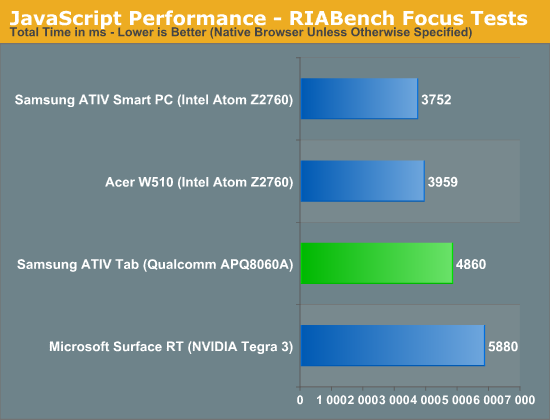
RIABench starts off as a teaser of what's to come: the APQ8060A is around 21% faster than NVIDIA's Tegra 3, but Intel's Atom Z2760 pulls ahead by nearly 30%.
Next up is SunSpider, a short to mid-length JavaScript benchmark that we've used for a while now:
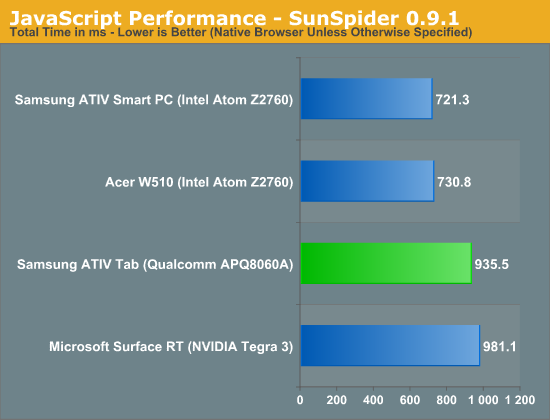
SunSpider shows a fairly close match between Qualcomm and NVIDIA, however once again Clover Trail is able to pull ahead by nearly 30%.
Finally we have Kraken, a seriously heavy javascript benchmark built by Mozilla. Kraken focuses on forward looking applications that are potentially too slow to run in modern browsers today. The result is much longer run times than anything we've seen thus far, and a very CPU heavy benchmark:
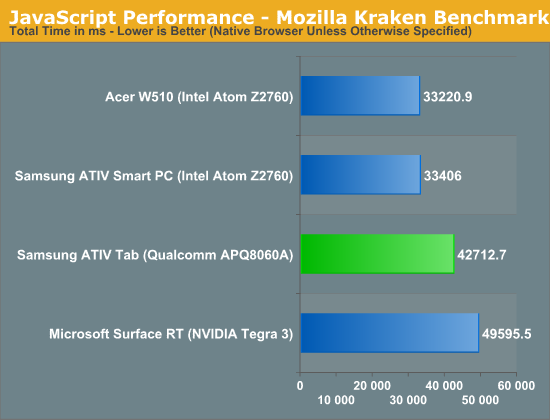
The Kraken results mimic RIABench: Qualcomm holds a 16% advantage over NVIDIA, while Intel manages a 28.5% advantage over Qualcomm.
We have one last web-based benchmark: WebXPRT by Principled Technologies (PT). WebXPRT measures performance in four HTML5/js workloads:
Photo Effects: Measures the time to apply effects to a set of six photos. The filters are Sharpen, Emboss, and Glow. WebXPRT applies each filter to two photos. This test uses HTML5 Canvas 2D and JavaScript.
Face Detect: Measures the average time to check for human faces in a photo. WebXPRT runs this test on five photos and uses the average time to calculate the final result. This test uses HTML5 Canvas 2D to get access to photo data. The detection algorithm is implemented in JavaScript.
Stocks Dashboard: Measures the time to calculate financial indicators of a stock based on historical data and display the result in a dashboard. The calculations are done in JavaScript, and the calculated stocks data is displayed using HTML tables and Canvas 2D.
Offline Notes: Measures the time to store notes securely in the browser's HTML5 local storage and display recent entries. This test uses using AES for security.
We're reporting the overall score after all tests have been run:
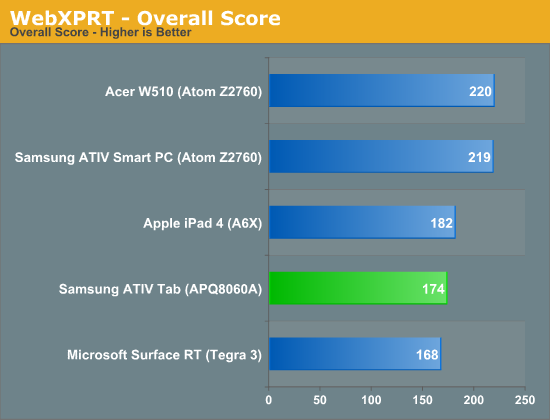
The WebXPRT tests show a narrower gap between Tegra 3 and APQ8060A, however the Intel advantage remains strong at 26%.
Next up are another set of benchmarks from PT, but unlike the WebXPRT suite these tests don't run in a browser. Once again we're looking at performance in a handful of tasks designed to stress the CPU:
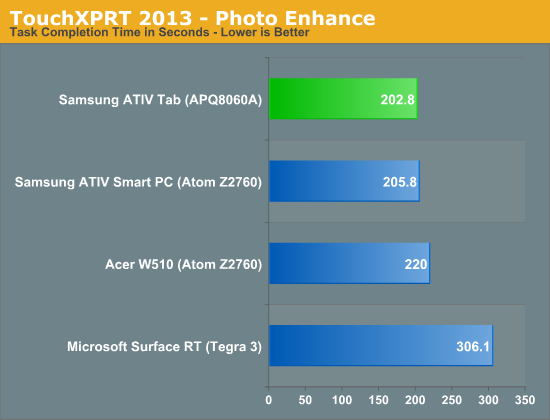
Now things are looking a bit different. Qualcomm is able to manage a slight victory over the Clover Trail equipped ATIV Smart PC. For all intents and purposes, APQ8060A equals the performance of Atom Z2760 in this test.
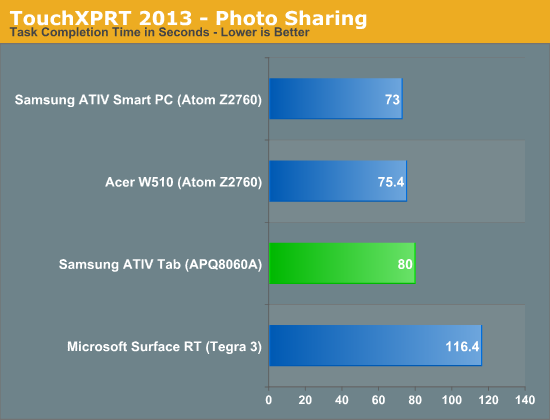
Intel pulls ahead a bit in the Photo Sharing benchmark, but Qualcomm remains quite competitive.
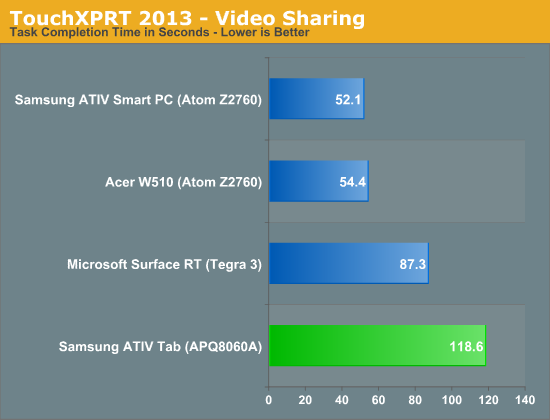
The one blemish on Qualcomm's TouchXPRT 2013 record is its performance in the video transcoding benchmark. Apparently this test sets up two decode streams (one for transcode and one for preview) and one encode stream, while Qualcomm's hardware decoder appears to be optimized for a single stream decode. The result is that both decode streams are interleaved, which increases the benchmark time. Qualcomm argues that for this type of a workload you'd typically setup a single decode stream and use that same stream for transcode and preview rather than setup two streams. Qualcomm was quick to point out that this isn't a Krait CPU limitation but rather a unique pairing of workload and decode hardware that resulted in the performance delta here.
Through the remaining two tests Qualcomm's performance remains close to Intel's:
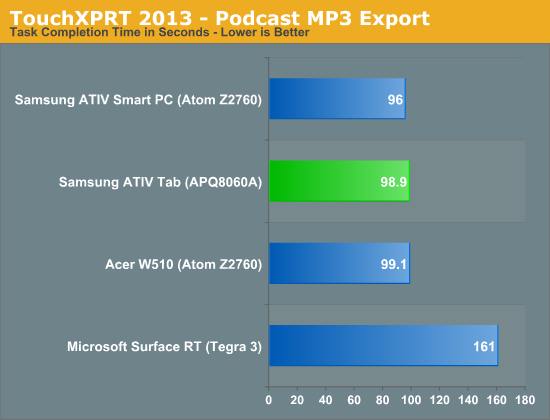
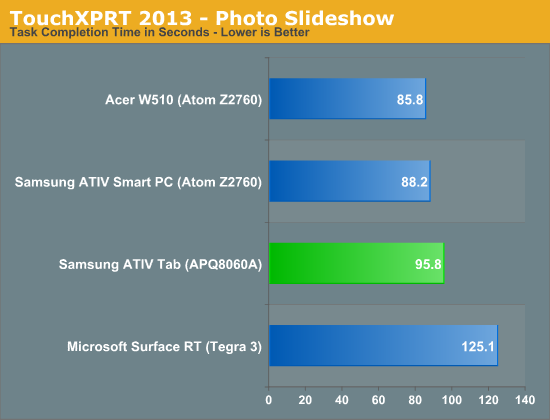
Intel manages an 11% performance advantage here, while Qualcomm's APQ8060A delivers a significant performance margin over Tegra 3.
In practice I'd say my experience with the ATIV Tab mirrored what these results showed. Qualcomm's superior single threaded performance resulted in a snappier desktop experience than what I got with Tegra 3 on Surface RT. In many cases, the ATIV Tab felt just as quick as Acer's Clover Trail based W510 although that wasn't always the case. UI performance in desktop mode was appreciably better than on the W510 however. Modern UI performance remains quick and smooth, as is the case with all Windows RT/8 tablets (Clover Trail does seem to get a slight edge here).
Although we don't yet have reliable 3D benchmarks we can run on Windows RT, from what I've seen it looks like the Adreno 225 hardware/driver implementation in Windows RT results in performance that's between Clover Trail and Tegra 3. Depending on the workload, I've even seen better performance out of APQ8060A/Adreno 225 than Tegra 3. It'll be a little while before we can fully quantify all of this though.


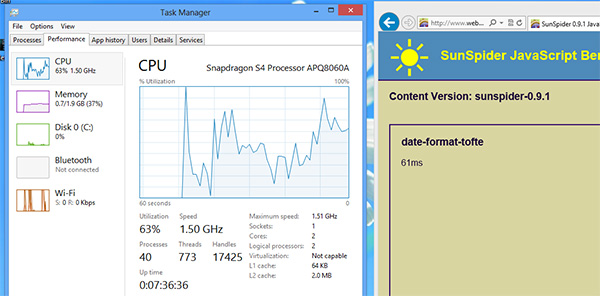








42 Comments
View All Comments
Tech-Curious - Thursday, January 3, 2013 - link
Well said.Especially this bit.
MonkeyPaw - Thursday, January 3, 2013 - link
Actually, once you use a nice high-Res device, it is quite difficult to go back to a cheap panel. My vision is by no means great, but the difference between a TF300T and a TF700T is quite noticeable.More to the current weakness of Windows 8--they need to get auto-correct going. So far, the touch keyboard is just that. MS just seems behind on system-wide text entry advancements.
Tech-Curious - Thursday, January 3, 2013 - link
I'm not saying that a higher resolution can't improve your subjective experience on a very small screen -- but at the screen size we're discussing, the difference is nebulous, undefinable.(The high-res panel might also have better color fidelity or a better contrast ratio, for example. Resolution isn't the only determinant of image quality -- and by definition, resolution becomes less determinant as screen size dwindles.)
High resolution is a luxury, and as BrokenCrayons points out, it's a costly luxury. To me, the benefit of a larger resolution is more than offset by the performance penalty. A tablet with a high-res screen will tend to cost more, and it will tend to age faster than a lower-res analogue. After all, your TF700T has to draw 222% more pixels than your TF300T. (2.28 million versus 1.024 million.)
Do you really think the TF700T looks 222% better? If you'd never used the TF700T, would the display on the TF300T bother you at all? The inferior tablet in your example boasts a pixel density 10% higher than the pixel density of the perfectly serviceable desktop monitor on which I'm typing this post, BTW.
As usual, the matter boils down to a value proposition. Of course a higher-resolution screen is better than a lower-resolution screen, all else being equal, but people on any kind of budget should consider how well a given resolution fits into their budget, both now and in the future. I say the same thing about desktop rigs; if you're a gamer, for example, and you get yourself accustomed to ultra-high-res and/or multi-monitor gaming, then you are signing yourself up for a very expensive hobby. You may only have to buy the monitor(s) once, but you're gonna have to keep shelling out for high-end video cards to accommodate it (them).
On the other hand, someone who is accustomed to (and content with) lower-resolution gaming can wring an immense amount of value out of their computer hardware. Likewise, a consumer who's content with less-than-preposterous resolutions on a tablet will wring more value out of his tablets. He'll feel compelled to upgrade less often, which is probably the reason tablet manufacturers are pushing high-res screens so hard lately. ;)
Tech-Curious - Thursday, January 3, 2013 - link
(That should say, "your TF700T has to draw 122% more pixels than the TF300T." The former has 222% as many pixels as the latter, not 222% more pixels. :)Tech-Curious - Thursday, January 3, 2013 - link
All of that said, and whether you think a high-res tablet display is worth it or not, I think we can agree that killerclick's original, disparaging comment ("LOL @ 1366x768") was unwarranted given the size of the screen we're discussing.MonkeyPaw - Friday, January 4, 2013 - link
In my search to replace my Iconia A500, I tried a W510, TF300T, and the TF700T. I am normally a value shopper too, but the older I get, the more my definition of value changes. I used my last tablet every day, almost exclusively at home, and I don't play FPS games on a tablet. It's not IF the screen is some quantitative amount better, it is if the clearly better screen is worth the extra cost. Considering you also get faster internals and better build quality for an additional $70, I'd say it's worth it. I didn't find that much variation in battery life, and the TF700T lasts "all day" and charges in a couple hours. I used 5% of my battery in 40 minutes of web browsing this morning.Tech-Curious - Friday, January 4, 2013 - link
I'm glad you're happy with your purchase. To clarify, it was never my intention to criticize the TF700T as a bad value in total. I'm actually a bit of an ASUS fanboy.As you point out, there's more to the product than just the screen's resolution. My only point is that high resolution is a burden on the rest of the system. Like BrokenCrayons, I question how much practical use the consumer gets out of 1900x1200 on a 10.1" screen.
ninjacut - Thursday, January 3, 2013 - link
Its absolutely worth the price, considering it runs a full OS and not a Phone OS. If you compare the footprint, WP8 has same size has Android or iOS.Now add multi-user, desktop, office, file system, network share, with desktop grade utilities like power shell, explorer, task manager, disk manager, etc. etc. etc then obviously the footprint will be large.
Is that too difficult to realize?
mayankleoboy1 - Thursday, January 3, 2013 - link
Anand, both SunSpider and Kraken are outdated benchmarks. Browsers have optimisations for them, which doesnt translate into real world performance.The best benchmark is the "Google Octane". It consist of all real world tests.
DanNeely - Thursday, January 3, 2013 - link
Any idea when this will be finished? We've seen battery results a few weeks ago alongside the Acer 510 review; and you've added CPU/GPU numbers on it in this review. What's left to do before the writeup?